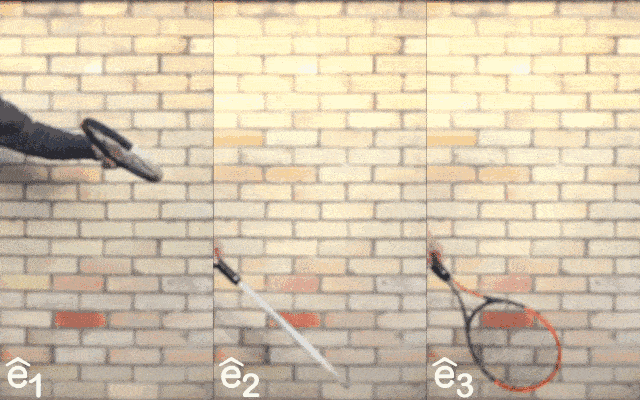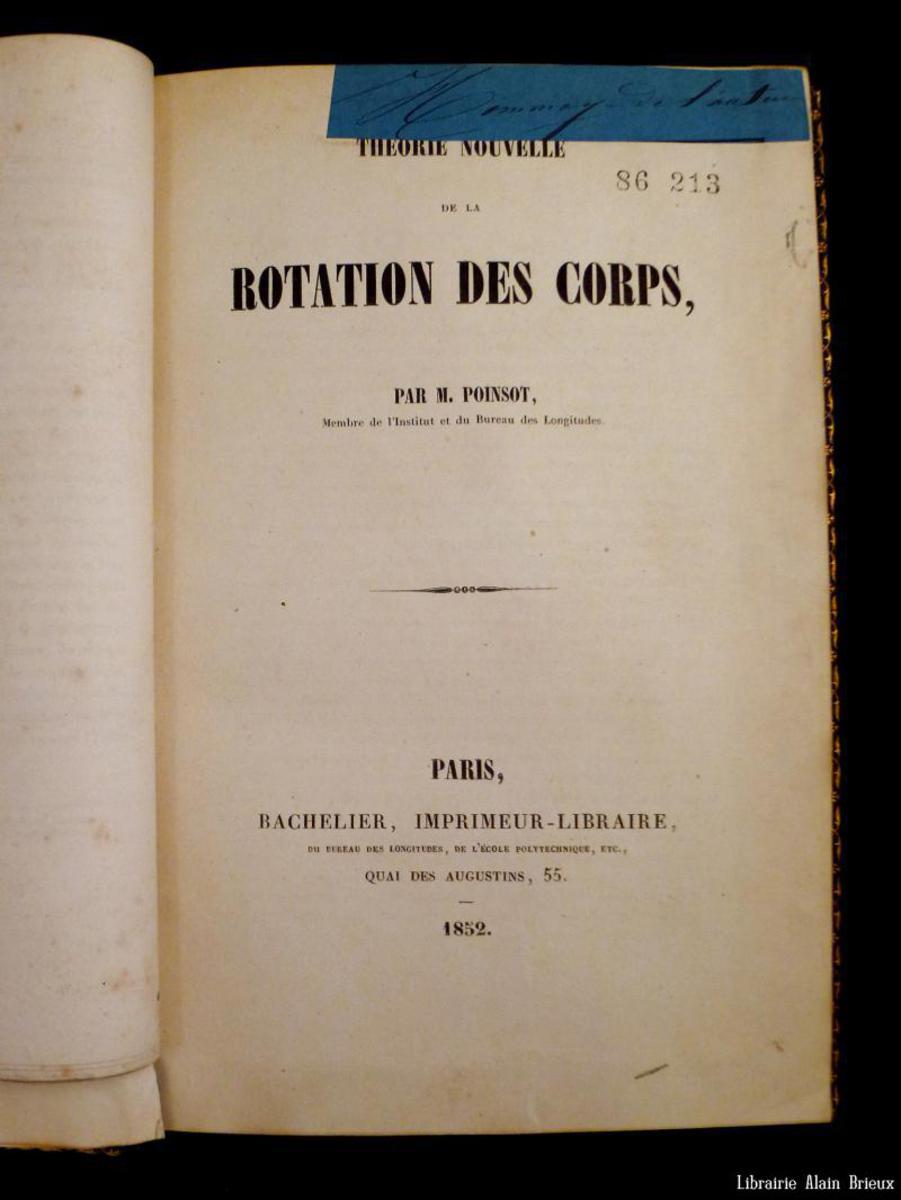Tennis racket theorem on:
[Wikipedia]
[Google]
[Amazon]


 The tennis racket theorem or intermediate axis theorem is a result in
The tennis racket theorem or intermediate axis theorem is a result in
 The tennis racket theorem can be qualitatively analysed with the help of Euler's equations.
Under
The tennis racket theorem can be qualitatively analysed with the help of Euler's equations.
Under
Théorie nouvelle de la rotation des corps
Paris, Bachelier, 1834, 170 p. : historically, the first mathematical description of this effect. *{{Cite web, last=, first=, date=, title=Ellipsoids and The Bizarre Behaviour of Rotating Bodies, url=https://www.youtube.com/watch?v=l51LcwHOW7s, url-status=live, archive-url=, archive-date=, access-date=, website=

 The tennis racket theorem or intermediate axis theorem is a result in
The tennis racket theorem or intermediate axis theorem is a result in classical mechanics
Classical mechanics is a physical theory describing the motion of macroscopic objects, from projectiles to parts of machinery, and astronomical objects, such as spacecraft, planets, stars, and galaxies. For objects governed by classical ...
describing the movement of a rigid body
In physics, a rigid body (also known as a rigid object) is a solid body in which deformation is zero or so small it can be neglected. The distance between any two given points on a rigid body remains constant in time regardless of external force ...
with three distinct principal moments of inertia
The moment of inertia, otherwise known as the mass moment of inertia, angular mass, second moment of mass, or most accurately, rotational inertia, of a rigid body is a quantity that determines the torque needed for a desired angular acceler ...
. It is also dubbed the Dzhanibekov effect, after Soviet
The Soviet Union,. officially the Union of Soviet Socialist Republics. (USSR),. was a List of former transcontinental countries#Since 1700, transcontinental country that spanned much of Eurasia from 1922 to 1991. A flagship communist state, ...
cosmonaut
An astronaut (from the Ancient Greek (), meaning 'star', and (), meaning 'sailor') is a person trained, equipped, and deployed by a human spaceflight program to serve as a commander or crew member aboard a spacecraft. Although generally r ...
Vladimir Dzhanibekov
Vladimir Aleksandrovich Dzhanibekov (russian: Владимир Александрович Джанибеков, born 13 May 1942) is a former cosmonaut who made five flights.
Biography
Dzhanibekov was born Vladimir Aleksandrovich Krysin (russia ...
who noticed one of the theorem's logical consequence
Logical consequence (also entailment) is a fundamental concept in logic, which describes the relationship between statements that hold true when one statement logically ''follows from'' one or more statements. A valid logical argument is on ...
s while in space in 1985, although the effect was already known for at least 150 years before that and was included in a book by Louis Poinsot
Louis Poinsot (3 January 1777 – 5 December 1859) was a French mathematician and physicist. Poinsot was the inventor of geometrical mechanics, showing how a system of forces acting on a rigid body could be resolved into a single force and a c ...
in 1834.
The theorem describes the following effect: rotation of an object around its first and third principal axes is stable, while rotation around its second principal axis (or intermediate axis) is not.
This can be demonstrated with the following experiment: hold a tennis racket at its handle, with its face being horizontal, and try to throw it in the air so that it will perform a full rotation around the horizontal axis perpendicular to the handle, and try to catch the handle. In almost all cases, during that rotation the face will also have completed a half rotation, so that the other face is now up. By contrast, it is easy to throw the racket so that it will rotate around the handle axis (ê1 in the diagram) without accompanying half-rotation around another axis; it is also possible to make it rotate around the vertical axis perpendicular to the handle (ê3) without any accompanying half-rotation.
The experiment can be performed with any object that has three different moments of inertia, for instance with a book, remote control, or smartphone. The effect occurs whenever the axis of rotation
Rotation around a fixed axis is a special case of rotational motion. The fixed-axis hypothesis excludes the possibility of an axis changing its orientation and cannot describe such phenomena as wobbling or precession. According to Euler's rota ...
differs only slightly from the object's second principal axis; air resistance or gravity are not necessary.
Theory
 The tennis racket theorem can be qualitatively analysed with the help of Euler's equations.
Under
The tennis racket theorem can be qualitatively analysed with the help of Euler's equations.
Under torque
In physics and mechanics, torque is the rotational equivalent of linear force. It is also referred to as the moment of force (also abbreviated to moment). It represents the capability of a force to produce change in the rotational motion of th ...
–free conditions, they take the following form:
Here denote the object's principal moments of inertia, and we assume . The angular velocities around the object's three principal axes are and their time derivatives are denoted by .
Stable rotation around the first and third principal axis
Consider the situation when the object is rotating around axis with moment of inertia . To determine the nature of equilibrium, assume small initial angular velocities along the other two axes. As a result, according to equation (1), is very small. Therefore, the time dependence of may be neglected. Now, differentiating equation (2) and substituting from equation (3), because and . Note that is being opposed and so rotation around this axis is stable for the object. Similar reasoning gives that rotation around axis with moment of inertia is also stable.Unstable rotation around the second principal axis
Now apply the same analysis to axis with moment of inertia This time is very small. Therefore, the time dependence of may be neglected. Now, differentiating equation (1) and substituting from equation (3), Note that is ''not'' opposed (and therefore will grow) and so rotation around the second axis is ''unstable''. Therefore, even a small disturbance along other axes causes the object to 'flip'.See also
* * * *References
External links
* * onMir
''Mir'' (russian: Мир, ; ) was a space station that operated in low Earth orbit from 1986 to 2001, operated by the Soviet Union and later by Russia. ''Mir'' was the first modular space station and was assembled in orbit from 1986 to&n ...
International Space Station
The International Space Station (ISS) is the largest modular space station currently in low Earth orbit. It is a multinational collaborative project involving five participating space agencies: NASA (United States), Roscosmos (Russia), JAXA ...
*
*Louis Poinsot
Louis Poinsot (3 January 1777 – 5 December 1859) was a French mathematician and physicist. Poinsot was the inventor of geometrical mechanics, showing how a system of forces acting on a rigid body could be resolved into a single force and a c ...
Théorie nouvelle de la rotation des corps
Paris, Bachelier, 1834, 170 p. : historically, the first mathematical description of this effect. *{{Cite web, last=, first=, date=, title=Ellipsoids and The Bizarre Behaviour of Rotating Bodies, url=https://www.youtube.com/watch?v=l51LcwHOW7s, url-status=live, archive-url=, archive-date=, access-date=, website=
YouTube
YouTube is a global online video platform, online video sharing and social media, social media platform headquartered in San Bruno, California. It was launched on February 14, 2005, by Steve Chen, Chad Hurley, and Jawed Karim. It is owned by ...
- intuitive video explanation by Matt Parker
Matthew Thomas Parker (born 22 December 1980) is an Australian recreational mathematician, author, comedian, YouTube personality and science communicator based in the United Kingdom. His book ''Humble Pi'' was the first maths book in the UK to ...
Classical mechanics
Physics theorems
Juggling